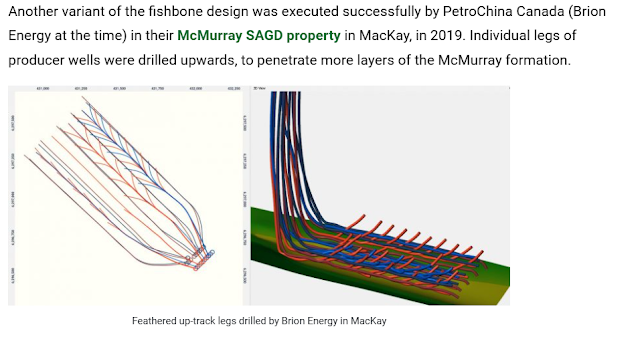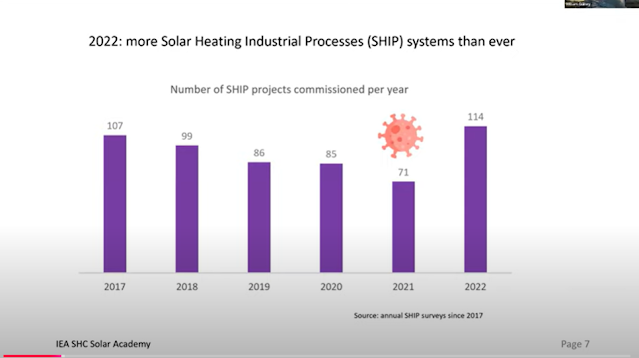In recent years
the impressive lengths of horizontal well lateral sections, approaching 30,000
ft in some cases, have been emphasized. However, there are other emerging horizontal
and multilateral well designs that are being used to better access reserves and
better optimize their production.
It is not
uncommon for directional drillers to have to steer around certain areas, often
due to unleased acreage. I have worked on several wells that have turned the
azimuth several degrees to avoid crossing areas where access is forbidden. I have
also worked on many wells where the curve was drilled behind or to the side to
maximize lateral footage.
Multilateral
wells have a single main wellbore and usually several shorter wellbores
branching off. Other designs may include two main wellbores. These wells as
well as multiple wells on a single pad require what is known as anti-collision
analysis. This involves planning for each leg trajectory and not deviating too
much from each trajectory.
The U-shaped
lateral has emerged as a preferred way to optimize acreage access and
production. These are becoming more popular every year in applicable situations.
Canada’s thermal
oil plays require optimized reservoir access for different reasons. Some of
these wells are stimulated with steam to produce the oil and these designs are
how reservoir access is optimized.
The U-Lateral/U-Turn/Paperclip/Horseshoe Pattern
The U-lateral is
a preferred design for its simplicity and order. The goal is really to have two
parallel well bores to take advantage of the optimum regional stresses. These
laterals can be drilled with existing technology and as World Oil reports there
are now about 70 of these wells drilled. They can allow an operator to better
optimize their use of acreage. As noted, since the first U-lateral was drilled
by Shell in 2019, there are now about 70, with 27 drilled in 2023 and more than
that drilled so far in 2024.
Shell's 2019 U-Lateral. Source: Journal of Petroleum Technology
The Delaware
Basin is the most active area for U-laterals with 30 wells but as shown below
they have been drilled in several U.S. basins. The Denver-Julesburg (JD) basin
is second with 14 wells. Occidental and PDC lead in U-laterals with ten each. Chevron
bought PDC and thus far has drilled five more U-laterals. Matador has noted cost savings on their U-lateral projects. The cost savings comes mainly from doubling the
amount of horizontal that can be drilled with a single vertical section of the
well. Two-mile lateral is more
economical than a one-mile lateral. Shell noted cost savings on their first U-lateral:
“From an economic perspective, the horseshoe well saved
25% on rig time and about 20% on total cost compared with drilling two wells of
the same lateral lengths. To a lesser degree, some savings was achieved on the
completions side by requiring only one coiled-tubing run instead of two.”
Hole sizes for U-laterals have varied between 6” and 8-3/4”. The turn has not been a problem with modern rotary steerable system (RSS) drilling motors as long as dogleg severity (DLS) stays as projected. Some wells can be drilled to total measured depth without tripping out. World Oil is the source of the following two graphics
Locations of U-Laterals. Source: World Oil
In the case of
Shell’s early U-lateral, the wellbores were left 1300 ft apart leaving room
between them for another well. I wonder how often that is applicable and what the shortest distance achievable of the parallel wellbores of a single U-lateral is. It appears that a well in between the U would be required in most cases since that can really optimize spacing. I would think that a 10-12 degree turn per a hundred feet means that
turning 180 degrees could take as much as 1800 feet with much of that section
being at less-than-ideal orientation. Thus, I also wonder where frac stages may
end on the U part of the lateral. I would think some of the U could host frac
stages.
A good thing
about U-laterals as opposed to multilaterals is that U-laterals do not have
junctions where the multilaterals connect to the main lateral. U-laterals utilize
a single lateral which is less risky for several issues.
Chinook Consulting’s Calin Dragoie wrote about some of the U-laterals in the Permian and Eagle Ford in Texas. The graphics below come from his post. The last two show how a U-shaped well provides ideal spacing if a lateral is drilled between the U.
Below is a graphic by Chinook Consulting where you can see some of the emerging U-lateral spacing and patterns being used in the Delaware and Midland portions of the Permian Basin and some of the companies drilling them.
Shell’s Fishhook Wells Offshore Brunei
In the early 2000s
Shell began drilling fishhook-shaped wells offshore Brunei in order to access
reservoirs from below from an onshore or nearshore drilling site. These are not
horizontal wells but deviated wells designed to reach reservoirs more economically.
The shape is due to the fact that they drill ‘uphill’ to get to the reservoir from
below due to the required geometries for turning the wellbore. This is an
example of optimizing the situation to access reservoirs economically. As noted
in the image below the Brunei reservoirs dip away from the shore.
Multilateral Drilling
Drilling
multilaterals is generally complex and riskier than drilling regular horizontal
wells. The well-funded oil majors have dominated multilateral drilling
globally. Depending on the geological situation they may be the best way to
access and produce the most hydrocarbons. One of the issues with multilaterals
is simply that there are junctions between the main lateral and the smaller lateral
that branch off from it. Each junction can be subject to problems, especially
with drilling and casing. Some multilaterals are just wells with multiple main
laterals of similar length. Others have one main lateral with others branching
off.
Multilateral
well junctions are made using a process known as open-hole sidetracking. This
makes a new branch. Wells drilled horizontally from another horizontal wellbore
are called branches. If a new leg drills out of the horizontal plane to a different
formation it is known as a splay. A guide to multilateral drilling from Drillingmanual.com
gives six levels of junctions. They note:
“The complexity of the multilateral drill depends on
the integrity of the formation, the prevention of water or gas coning, the requirements to
isolate the main wellbore from the laterals, the requirement to reenter each
lateral, and the requirements to isolate production from the laterals.”
Junctions may
be cased or uncased. Cased junctions are better for controlling production. Economics
drives decisions to drill multilaterals. Sometimes there are geological reasons
to drill them such as tapping into different reservoirs from complex fault blocks.
A Level 1 junction has the main wellbore and the lateral left uncased at the junction, as shown below. This is the most common type of junction. The graphic below shows all six levels of junctions.
In a Level 2
junction, the main wellbore is typically cased and cemented, while the lateral,
or at least the junction, is left uncased. This is the second most common type
of junction.
The main
wellbore in a Level 3 junction of multilateral drilling wells technology is
cased and cemented, while the laterals are not cemented but cased only.
A Level 4 junction has both the main wellbore and the laterals cased and cemented, as shown in Figure 2 above.
A Level 5
junction builds upon the Level 4 system by providing pressure integrity at the
junction. The pressure integrity is achieved in the completion by running
tubing and isolation packers.
A Level 6 junction attains full pressure integrity for maximum control. It is explained below and shown in Figure 2:
“Level 6 junction is one in which full pressure
integrity is achieved with the main casing string. There are two types of level
6 junctions: expandable metal junctions and splitter. They are used in new
installations only because the expandable metal junction or splitter must be
run as part of the casing string. The expandable metal junction requires
under-reaming the hole where the junction will be placed to expand the junction
before setting cement. The splitter junction requires drilling a much larger
diameter hole from the surface down to run the splitter. For this reason,
splitters are usually run at shallower depths.”
Canadian Thermal Oil Plays Multilateral Designs:
Fishbone, Feather, and Stacked Multilaterals
The graphics in
this section come from Chinook Consulting Services. They have geosteered many
of these Western Canadian Basin multilaterals wells and are the experts.
In the late 2000s
wells drilled in the Jean-Maie field in Northeastern British Columbia in the Western
Canadian Sedimentary Basin, were commonly drilled as two or three-legged
multilaterals as shown in the map and graphic below. Encana was a main player.
Collector
multilaterals drilled between existing pads of Bluesky wells in the Peace River
oil sands were a precursor to the fishbone and feather multilateral patterns. The
long and straight legs act as collectors and the many shorter lateral legs extend
the drainage area. One well, drilled in 2016 has 47 legs and a total lateral
length of 25,000 meters! Some fishbone and feather designs are shown below.
Stacked laterals
can also be of several types. They can be multilaterals drilled into the same
formation with separate multilateral wells drilling into formations above and/or
below. They can be a single multilateral well that accesses two or more
vertically separated formations. The wine-rack geometry shown below is another type
of stacked lateral where formations are alternated in adjacent legs. As also
shown below, Devon drilled several stacked fishbone designs.
References:
Paperclip
Wells: new well design in the Permian Basin. Calin Dragoie. February 10, 2024. (25) Paperclip Wells: new well design
in the Permian Basin | LinkedIn
Why
Shell Drilled a “Horseshoe” Well in the Permian Basin. Trent Jacobs. Journal of
Petroleum Technology. February 10, 2020. Why
Shell Drilled a “Horseshoe” Well in the Permian Basin
U-lateral
drilling innovations: Making breakthroughs possible for directional projects. Gordon
Feller. World Oil. October 2024. U-lateral
drilling innovations: Making breakthroughs possible for directional
projects
Multilateral
Wells Drilling Technology Full Guide. Drillingmanual.com. August 9, 2021. Multilateral
Wells Drilling Technology Full Guide - Drilling Manual
Drilling
Uphill. Paul Wood. GeoExPro. September 3, 2010. Drilling Uphill - GeoExpro
Multilateral,
Feather, Fishbone: A look at Well Designs in a Mature Basin. Calin Dragoie. Chinook
Consulting Services. October 26, 2020. Well design
in a mature basin • Chinook Consulting

































































